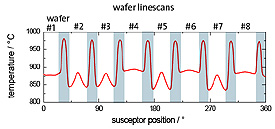At the International Conference on Nitride Semiconductors (ICNS) in Korea on 18-23 October LayTec presented its latest product: Pyro 400. Unlike conventional infrared pyrometry, which can only detect the susceptor surface temperature under sapphire or SiC wafers, Pyro 400 is the first real solution for measuring the exact surface temperature of GaN layers. The tool performs pyrometry at 400 nm. At this wavelength GaN emits light and makes it possible to measure its temperature.
 Pyro 400 linescan measurement of 8x3“ configuration. Dummy wafers with a strong concave bowing (#2, 3, 5, 7) have a different temperature profile than GaN templates with just a slight concave bowing (#4, 5, 8). Blue background marks the gaps between wafers.
Pyro 400 linescan measurement of 8x3“ configuration. Dummy wafers with a strong concave bowing (#2, 3, 5, 7) have a different temperature profile than GaN templates with just a slight concave bowing (#4, 5, 8). Blue background marks the gaps between wafers.
At the ICNS Dr. Kolja Haberland of LayTec presented the results obtained during growth of GaN LED structures containing multi quantum wells (MQW). The Figure shows a typical linescan measurement: Pyro 400 monitoring the wafer temperature profile during a full revolution of the susceptor. The data provides direct access to the GaN temperature distribution across each wafer in a planetry reactor. Together with the complementary reflectance and curvature data measured by EpiCurve®, the in-situ measurements give all important information needed to optimize uniformity and LED performance. The data clearly shows that wafer bowing causes changes in temperature distribution and proves that the center of concave bowed wafers is hotter.
Dr. Haberland also reported that the real surface temperature of GaN is sensitive to changes of carrier gas, rotation speed, and reactor pressure. These deviations can not be detected by conventional infrared pyrometry measurements at all. Additionally to these advantages, there are no emissivity oscillations during GaN buffer growth, which makes Pyro 400 an ideal tool for temperature feed-back control application. In summary, Pyro 400 provides a new quality of temperature measurement with an unrivalled accuracy and will be of huge benefit in GaN based LED and laser production in the near future. Our results were also presented at LayTec in-situ seminar held in conjunction with the ICNS. You can download the Pyro 400 talk as well as all other talks hold at the seminar on LayTec website: www.laytec.de/compounds-presentations.html